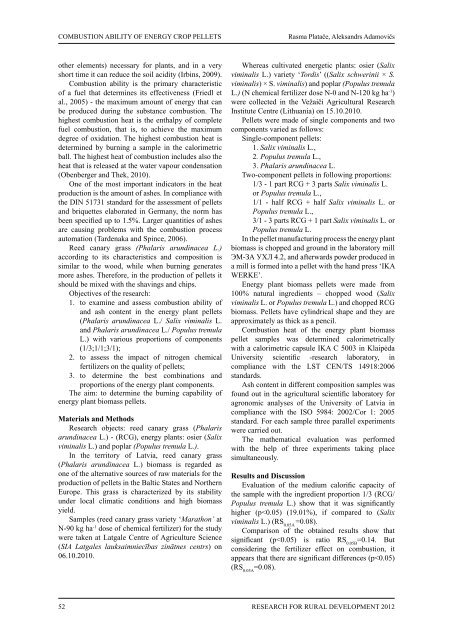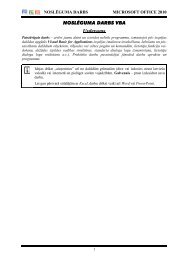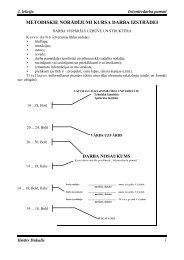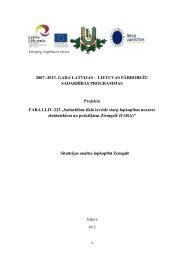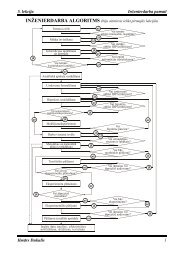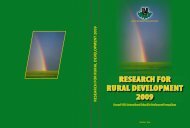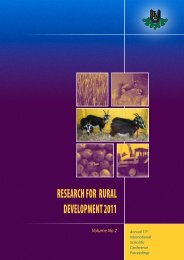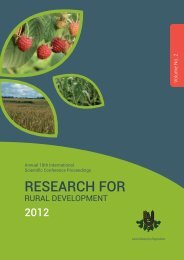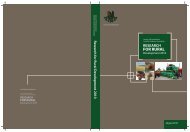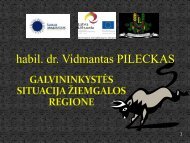Rasma Platače, Aleksandrs AdamovičsCOMBUSTION ABILITY <strong>OF</strong> ENERGY CROP PELLETSEven if perfectly dried, firewood contains 20-30%more moisture than a pellet. As a result, due to thefact that ‘air’ and ‘water’ are not transported, thetransportation of pellets is much more effective thantransportation of any other biomass.The highest quality pellets have natural woodcolour, they are clean, pleasantly fragrant and smooth.Pellets for heating are produced from 100% naturalmaterial-wood shavings. Pellets are cylindrical inshape and approximately as thick as a pencil (Irbins,2009).Pellets have several advantages, if compared totheir raw material - wood shavings - because they aremore compact, more easily transportable and, the mostimportant, they can be obtained from wood residuesand therefore pellets are produced from are renewableresources. Wood combustion process is less harmful:carbon dioxide released to the atmosphere does noshift balance in nature, and does not increase thegreenhouse effect, unlike black fuel oil or fossil fuels(Tardenaka and Spince, 2006).The studies show that, if residential houses areheated with pellets instead of black fuel oil, thereleased CO 2pollution is reduced by about 4.8 tons peryear, but substitution of gas-fired central heating leadsto the reduction of the emitted CO 2by approximately2.5 t per year. Transportation and storage of pelletsdoes not pose risk for the environment. Ash generallycan be used as chemical fertilizers, since chemicalelements in its content usually do not exceed thespecified limits (Enerģētisko …, 2007).Increase of biomass on the Earth every year isvalued as 200 billion tonnes. Although biomass energypotential is 10 times higher than possibilities of fossilfuels, still the use of biomass is very complicated. Incomparison with the fossil fuel, the natural fuel haslower heat output. For fresh carved wood it is 2.9,for dry - 4.28, for cardboard - 4.39, for black fueloil - 11.73, for coal from - 6.5 to 9, and for naturalliquefied gas - 14.33 kWh kg -1 . Technologies for theuse of biomass are constantly improved, but fossil fuelresources are running short, so in future we can expectfaster price rises. For the past 15 years, the heat andpower generation from biomass in the EU countrieshas been increasing by 2 - 9% per year, while currentlybiomass constitutes only about 5% of the total energyproduced (Zaķe et al., 2010).At present wood products (firewood, woodchips,and pellets) are the most popular renewable fuels inLatvia. However, also wood resource regenerationability is limited in time and space. In many countriescultivation of various plants is recommended asan alternative to the thermal energy production(Adamovičs et al., 2009; Белосельский and Соляков,1980).One of the alternatives used for the biomassproduction is cultivation of grasses (Phalarisarundinacea L., Festuca arundinacea L., etc.).Evaluating the reed canary grass as a fuel, it should benoted that it is very suitable for the use in automaticboilers.However, use of the reed canary grass for theheat production is characterized by major problemsin burning process, such as the quantity of ashes,composition of flue gases and ash melting temperature(Boateng et al., 2006).Production of thermal energy (from pellets) wouldneed cultivated plants with high biomass yield, goodcombustibility, higher heat output and lower content ofashes. Finding the most appropriate reed canary grasscomposition (reed canary grass biomass together withbiomass osier and poplar biomass) with the best pelletcombustion ability will result in the best and the mostefficient solution. And perhaps in future there will beeconomies specializing directly on cultivation of reedcanary grass intended for heating and its use in themanufacture of pellets.One of the most significant indicators of the fuelmaterial quality is ash. However, larger quantitiesof ash are causing problems with automation of thecombustion process (Tardenaka and Spince, 2006).The most important indicator in the productionof thermal energy is the quantity of ashes, whichaccording to the standard (DIN 51731) rates up to15 g kg -1 . Higher ash contents are causing problemswith automation of the combustion process. Inaddition, heating capacity of such pellets is 600 –1000 kJ kg -1 lower, for example, for the bark briquetteshaving ash content of 140 g kg -1 heating capacitycomprises 16711 kJ kg -1 (by the standard DIN 51731,net calorific value must reach at least 17500 kJ kg -1 ).Fuel combustion heat is a key performance indicator,which largely depends on the amount of moisture andashes. At mean granule moisture of 67 – 78 g kg -1 itranges from 18400 to 17700 kJ kg -1 .New standards for the production of pellets-DINPlus-indicate that ash content must not exceed 0.5%(Tardenaka and Spince, 2006).Wood ashes have almost a full set of mineralsrequired by the plants. They contain macro-elements(except nitrogen) and trace elements in the form ofoxides and carbonates. Wood ash, depending on thetree specie, contain 40 – 200 g kg -1 of potassium, 180 –300 g kg -1 of calcium, and 5 – 10 g kg -1 of phosphorus.The effect left by the ash is lasting for three to fouryears; it can be used as a fertiliser annually, on averageproviding 300 - 400 g per square meter. Wood ashis a valuable source of minerals and high-qualityalkali, containing more than 30 nutrients (potassium,calcium, magnesium, iron, phosphorus, sulphur, andResearch for Rural Development 201251
COMBUSTION ABILITY <strong>OF</strong> ENERGY CROP PELLETSRasma Platače, Aleksandrs Adamovičsother elements) necessary for plants, and in a veryshort time it can reduce the soil acidity (Irbins, 2009).Combustion ability is the primary characteristicof a fuel that determines its effectiveness (Friedl etal., 2005) - the maximum amount of energy that canbe produced during the substance combustion. Thehighest combustion heat is the enthalpy of completefuel combustion, that is, to achieve the maximumdegree of oxidation. The highest combustion heat isdetermined by burning a sample in the calorimetricball. The highest heat of combustion includes also theheat that is released at the water vapour condensation(Obenberger and Thek, 2010).One of the most important indicators in the heatproduction is the amount of ashes. In compliance withthe DIN 51731 standard for the assessment of pelletsand briquettes elaborated in Germany, the norm hasbeen specified up to 1.5%. Larger quantities of ashesare causing problems with the combustion processautomation (Tardenaka and Spince, 2006).Reed canary grass (Phalaris arundinacea L.)according to its characteristics and composition issimilar to the wood, while when burning generatesmore ashes. Therefore, in the production of pellets itshould be mixed with the shavings and chips.Objectives of the research:1. to examine and assess combustion ability ofand ash content in the energy plant pellets(Phalaris arundinacea L./ Salix viminalis L.and Phalaris arundinacea L./ Populus tremulaL.) with various proportions of components(1/3;1/1;3/1);2. to assess the impact of nitrogen chemicalfertilizers on the quality of pellets;3. to determine the best combinations andproportions of the energy plant components.The aim: to determine the burning capability ofenergy plant biomass pellets.Materials and MethodsResearch objects: reed canary grass (Phalarisarundinacea L.) - (RCG), energy plants: osier (Salixviminalis L.) and poplar (Populus tremula L.).In the territory of Latvia, reed canary grass(Phalaris arundinacea L.) biomass is regarded asone of the alternative sources of raw materials for theproduction of pellets in the Baltic States and NorthernEurope. This grass is characterized by its stabilityunder local climatic conditions and high biomassyield.Samples (reed canary grass variety ‘Marathon’ atN-90 kg ha -1 dose of chemical fertilizer) for the studywere taken at Latgale Centre of Agriculture Science(SIA Latgales lauksaimniecības zinātnes centrs) on06.10.2010.Whereas cultivated energetic plants: osier (Salixviminalis L.) variety ‘Tordis’ ((Salix schwerinii × S.viminalis) × S. viminalis) and poplar (Populus tremulaL.) (N chemical fertilizer dose N-0 and N-120 kg ha -1 )were collected in the Vežaiči Agricultural ResearchInstitute Centre (Lithuania) on 15.10.2010.Pellets were made of single components and twocomponents varied as follows:Single-component pellets:1. Salix viminalis L.,2. Populus tremula L.,3. Phalaris arundinacea L.Two-component pellets in following proportions:1/3 - 1 part RCG + 3 parts Salix viminalis L.or Populus tremula L.,1/1 - half RCG + half Salix viminalis L. orPopulus tremula L.,3/1 - 3 parts RCG + 1 part Salix viminalis L. orPopulus tremula L.In the pellet manufacturing process the energy plantbiomass is chopped and ground in the laboratory millЭМ-ЗА УХЛ 4.2, and afterwards powder produced ina mill is formed into a pellet with the hand press ‘IKAWERKE’.Energy plant biomass pellets were made from100% natural ingredients – chopped wood (Salixviminalis L. or Populus tremula L.) and chopped RCGbiomass. Pellets have cylindrical shape and they areapproximately as thick as a pencil.Combustion heat of the energy plant biomasspellet samples was determined calorimetricallywith a calorimetric capsule IKA C 5003 in KlaipėdaUniversity scientific -research laboratory, incompliance with the LST CEN/TS 14918:2006standards.Ash content in different composition samples wasfound out in the agricultural scientific laboratory foragronomic analyses of the University of Latvia incompliance with the ISO 5984: 2002/Cor 1: 2005standard. For each sample three parallel experimentswere carried out.The mathematical evaluation was performedwith the help of three experiments taking placesimultaneously.Results and DiscussionEvaluation of the medium calorific capacity ofthe sample with the ingredient proportion 1/3 (RCG/Populus tremula L.) show that it was significantlyhigher (p


